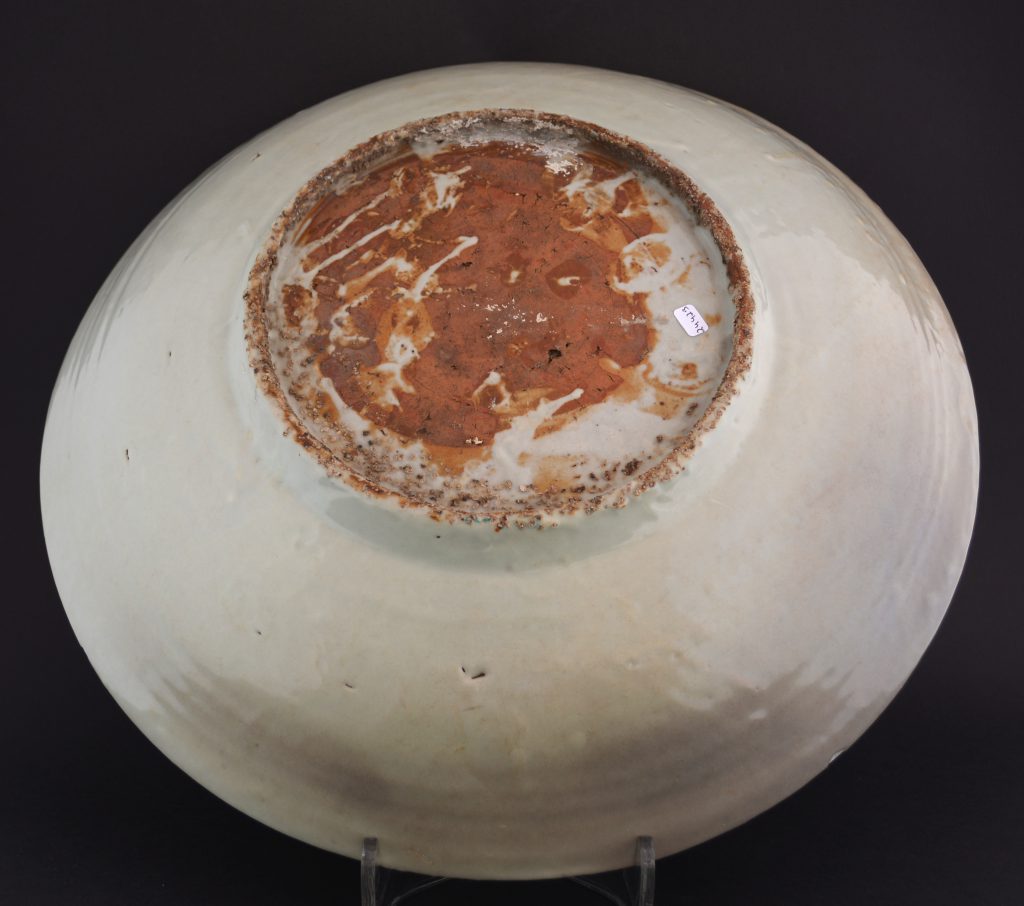
MING DYNASTY c.1600 – 1640 Swatow Ware
A Large Inscribed Ming Porcelain `Swatow` Ware Dish, Late Ming Dynasty, Wanli to Chongzhen Period c.1600-1640.
SOLD
- Condition
- Some chips and fritting ; the front has a rim chip c.9 x 5 mm and frit/rim chip c.11 x 4 mm. The back has two shallow chips c.19 x 4 mm (mostly glaze) and 9 x 3 mm (mostly glaze). Minor wear.
- Size
- Diameter : 39.5 cm (9 1/2 inches)
- Provenance
- N/A
- Stock number
- 24429
- References
- References : For a very similar Ming Swatow ware dish see : Zhangzhou Export Porcelain, the So-Called Swatow Wares (Various authors,Jorge Welsh Books, 2006 ISBN 0-9550992-4-2) page 133, item 28. For another Ming porcelain dish of this design see : Zhanzhou (Swatow) Ceramics, Sixteenth to Seventeenth Centuries Found in Indonesia (Sumarah Adhyatman, The Ceramic Society of Indonesia,1999) page 147, plate 193. For further Ming dishes with this design see : Swatow (Barbara Harrison, Museum Het Princessehof,1979) plates 104 and 109, for a dish with a different border see 206. Another Ming Swatow porcelain dish with a compass design from the Percival David collection is now in the British Museum, reference PDF 700. A large fragment of a bowl with a similar central design was excavated from the Dongkou kiln site in Wuzhai, Pinhe County. For a dish of this size and design see our `Sold Items` number 22215.
Information
From the Kilns in Pinghe or Hua`an Kilns in Heping County, Zhangzhou Prefecture, Fujian Province. The Center of this Ming Polychrome Dish has a Compass Which has a Two Character Inscription in the Center 太極 Tienxi Yi (Unity Under Heaven), Arranged Around the Edge of the Compass is a Twenty Four Character Inscription Representing the Jikkan Junishi, Literally `Ten Heavenly Stems` and `Twelve Terrestrial Branches` of the Chinese Zodiac. The Border is of Leaping Carp.
Compass Designs on Ming Swatow Wares :
Swatow ware produced at various kilns in Zhangzhou Prefecture, Fujian Province was a type of Chinese export porcelain decorated in blue and white or bright overglaze enamels, often with a predominance of a flat somewhat rusty red. Swatow wares were shipped to many countries including Japan, Indonesia, the Philippines and Portugal. These were all great maritime nations, so perhaps it is unsurprising that marine compasses, both Chinese and European, should be included on some of the ceramics made for these countries. It is probably to Japan that we have to look for the origins of a group of designs with an oriental compass, these patterns include an inscribed compass in the middle of the design. A two character inscription within the center of compass, Tienxi Yi in Chinese and Tenka Ichi in Japanese, meaning `Unity Under Heaven` is Japanese in origin rather than Chinese. It date backs to the Japanese warlord Oda Nobunaga (1534-1582). The twenty four character inscription around the compass Jikkan Junishi, literally `Ten Heavenly Stems` and `Twelve Terrestrial Branches` of the Chinese Zodiac, alternating with one another is called Eto in Japanese. They were used together to create a cycle of 60 two symbol combinations, called the sexagenary (60 years) cycle, which was used as a method for counting years, days, hours and sometimes months in imperial court and civil calenders. European compasses were also incorporated within Swatow patterns, the origins of these designs are probably Portuguese or Dutch maps of the period, these Swatow designs often include European galleons.
(for more information see Zhangzhou Export Porcelain, the So-Called Swatow Wares, various authors,Jorge Welsh Books, 2006 ISBN 0-9550992-4-2, this is an excellent book about Swatow wares).






